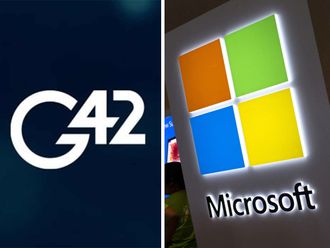Dubai: The Dubai Financial Market General Index (DFMGI) was essentially flat last week, rising only 5.55 or 0.17 per cent to close at 3,340.49. That’s not bad given that the index was down as much as 2.5 per cent earlier in the week. There were 12 advancing issues and 26 declining, while volume improved to a three-week high.
The index continued its decline earlier in the week as it fell below the prior week’s low before finding support at 3,253.21 on Monday and then bouncing into the week’s end. At the low the DFMGI was 10.5 per cent off its 2016 high of 3,623.70 reached only nine weeks ago.
In addition to the bullish reaction off the week’s low there is a bullish weekly candlestick formation that usually signals a reversal. It’s called a hammer and it reflects the switch from sellers being dominant to buyers dominating price action. This strength now needs to be confirmed by a daily close above last week’s high of 3,354.68.
Further supporting the odds that last week’s low is at least a short-term bottom is the completion of a classic reversal chart pattern. As discussed over the past couple of weeks, the DFMGI broke down from a bearish head and shoulders top trend reversal pattern several weeks ago. The size of the pattern indicated a minimum target of around 3,256. Given the bullish reaction off last week’s low, which is a very close match to the target, the impact from this pattern is likely complete. There’s a good chance that last week’s support zone will hold for another week or a few, if not longer. Short-term weakness from last week’s close will likely to see support above last week’s low.
Alternatively, if last week’s low is exceeded the index will be falling into a support zone all the way down to the 3,197 support area from May and therefore downside momentum should be muted.
Once last week’s high is exceeded the index will be targeting the two-week high around 3,395, followed by the underside of the head and shoulders top which starts around 3,430 and initially goes up to the six-week high at 3,556.
Abu Dhabi
The Abu Dhabi Securities Exchange General Index (ADI) fell 52.74 or 1.21 per cent last week to close at 4,294.46. Market breadth leant on the bearish side with 19 declining issues and 12 advancing, while volume reached a two-week high but was still at the second lowest level of the past nine weeks.
Support for the week was found at 4,216.93, right at the 200-week exponential moving average (ema). At that point that ADI had corrected 8.8 per cent off the most recent peak of 4,621.50 from 12 weeks ago, and was down 3.0 per cent for the week. Since December 2014 the index has bounced off support of its 200-week ema three times and each of those times a significant advance ensued. That may not happen this time but it looks like there’s a good chance that at least last week’s low will hold for now.
Therefore, short-term declines will likely be met with buying pressure as more investors agree that the eleven-week drop off the twelve-week high has come to an end. Last week’s high of 4,347.62 is the first resistance area to contend with on the way up. Once exceeded to the upside the ADI heads to the prior week’s high of 4,393.53. After that there is potential resistance around 4,433 to 4,443, consisting of the 55-week ema and the bottom of the previous consolidation wedge that had been forming before the breakdown several weeks ago, respectively.
Regardless, the ADI will be heading up into a good amount of overhead resistance reflecting downward pressure. This will be true until it can close above 4,518 on a daily basis. That would be the first sign that the ADI is improving for the intermediate-term and thereafter has a chance to test 2016 highs.
Stocks to watch
So far the top performing stock for the year in the UAE is Takaful House. It’s up 141.13 per cent year-to-date and 90.7 per cent over the past 12 months. Last week the stock closed flat at 1.02.
in mid-June Takaful really began to out perform as it broke out of a three and a half month base and gained as much as 138.8 per cent in about five weeks before hitting resistance at 1.17. That 2016 high in late-July has led to an 11-week retracement and consolidation phase which has evolved into a bullish pennant pattern. This is a classic trend continuation pattern which takes the form of a relatively small symmetrical triangle following a rapid rise.
At this point a rally and subsequent daily close above 1.09 would signal a bullish breakout but it would be healthier for the consolidation to continue to evolve for another two to five weeks before price breaks out. Given the prior sharp rally the more likely direction out of the consolidation is up and it should occur with some force. The minimum target derived from the triangle is 1.294, once a breakout occurs.
Alternatively, a drop below 0.952 gives a bearish signal and indicates that the pennant has failed.
Bruce Powers, CMT, is chief technical analyst at www.MarketsToday.net. He is based in Dubai.












